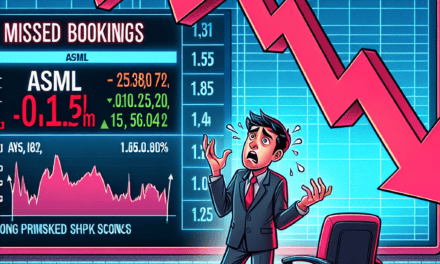“Unlocking Potential: Wall Street Bets Big on This Stock-Split Star!”
Introduction
Wall Street analysts are closely eyeing a particular stock-split company that is poised to potentially outperform the broader market. Stock splits, often seen as a strategic move to enhance liquidity and attract a broader base of investors, can sometimes signal a company’s robust growth prospects. This particular stock, having recently undergone a split, has captured the attention of market experts who believe its underlying fundamentals, coupled with favorable market conditions, position it for significant gains. As investors seek opportunities to maximize returns, this stock’s potential for outperformance makes it a compelling consideration in the current financial landscape.
Understanding Stock Splits: How They Impact Market Performance
Stock splits have long been a topic of interest among investors, as they often signal a company’s confidence in its future growth prospects. A stock split occurs when a company divides its existing shares into multiple new shares, thereby increasing the number of shares outstanding while maintaining the same overall market capitalization. This process does not inherently change the value of the company, but it can have significant implications for market performance. Wall Street analysts frequently scrutinize stock splits to predict which stocks might outperform the market, and understanding the mechanics and potential impacts of stock splits is crucial for investors seeking to capitalize on these opportunities.
To begin with, stock splits are typically executed to make a company’s shares more affordable and attractive to a broader range of investors. When a stock’s price becomes too high, it may deter smaller investors from purchasing shares. By splitting the stock, a company reduces the price per share, making it more accessible without altering the underlying value of the investment. This increased accessibility can lead to higher demand, as more investors are able to participate in the market for that particular stock. Consequently, this heightened demand can drive up the stock’s price, potentially leading to market outperformance.
Moreover, stock splits can serve as a positive signal to the market, indicating that a company is confident in its growth trajectory. Companies typically opt for stock splits when they anticipate continued strong performance and wish to maintain liquidity in their shares. This confidence can be contagious, as investors often interpret a stock split as a sign of robust financial health and future profitability. As a result, the announcement of a stock split can generate positive sentiment and increased investor interest, further contributing to potential market outperformance.
In addition to these psychological factors, stock splits can also have practical implications for market performance. For instance, a lower share price post-split can lead to increased trading volume, as more investors are able to buy and sell shares. This heightened liquidity can enhance price stability and reduce volatility, making the stock more attractive to institutional investors who prioritize stability in their portfolios. Furthermore, stocks that undergo splits may become eligible for inclusion in certain indices that have price or liquidity requirements, thereby attracting additional investment from index funds and exchange-traded funds (ETFs).
However, it is important to note that not all stock splits result in market outperformance. While a stock split can create favorable conditions for a stock’s price to rise, it does not guarantee success. Investors must consider other factors, such as the company’s overall financial health, industry trends, and macroeconomic conditions, when evaluating the potential impact of a stock split. Additionally, some critics argue that stock splits are merely cosmetic changes that do not address underlying business challenges or opportunities.
In conclusion, while stock splits can offer valuable insights into a company’s growth prospects and market potential, they should not be viewed in isolation. Wall Street’s predictions regarding stock-split stocks are often based on a combination of factors, including the company’s fundamentals and broader market conditions. By understanding the mechanics and implications of stock splits, investors can make more informed decisions and potentially identify stocks that are poised to outperform the market. As always, thorough research and careful analysis remain essential components of successful investing.
Wall Street’s Top Picks: Stock-Split Stocks to Watch
In the ever-evolving landscape of the stock market, investors are constantly on the lookout for opportunities that promise substantial returns. Among the myriad of strategies employed, stock splits have garnered significant attention, particularly when Wall Street analysts identify a stock-split stock with the potential to outperform the market. A stock split, fundamentally, is a corporate action that increases the number of a company’s outstanding shares by issuing more shares to current shareholders. While the total value of the shares remains unchanged, the price per share is adjusted accordingly. This maneuver often makes the stock more accessible to a broader range of investors, potentially increasing liquidity and market interest.
One such stock that has recently caught the eye of Wall Street analysts is a company that has not only demonstrated robust financial health but also executed a strategic stock split. The rationale behind this prediction is multifaceted. Firstly, the company operates in a sector that is poised for growth, driven by technological advancements and increasing consumer demand. This sector’s expansion is expected to provide a favorable backdrop for the company’s continued success. Moreover, the company’s management has consistently demonstrated a commitment to innovation and operational efficiency, which are critical factors in maintaining a competitive edge.
Furthermore, the company’s recent financial performance has been impressive, with quarterly earnings consistently surpassing market expectations. This track record of strong earnings growth is a testament to the company’s ability to adapt to changing market conditions and capitalize on emerging opportunities. Additionally, the company’s balance sheet remains robust, with a healthy cash flow and manageable debt levels, providing it with the financial flexibility to invest in future growth initiatives.
Another compelling reason for Wall Street’s optimism is the company’s strategic initiatives aimed at expanding its market share. Through targeted acquisitions and partnerships, the company has successfully entered new markets and diversified its product offerings. These strategic moves not only enhance the company’s growth prospects but also mitigate risks associated with market volatility. As a result, the company is well-positioned to capture a larger share of the market, further bolstering its revenue streams.
Moreover, the stock split itself is indicative of the company’s confidence in its future prospects. By making its shares more affordable, the company is likely to attract a broader base of investors, including retail investors who may have been previously deterred by a higher share price. This increased investor interest can lead to greater stock liquidity, which is often viewed favorably by the market.
In conclusion, Wall Street’s prediction that this stock-split stock could outperform the market is grounded in a comprehensive analysis of the company’s financial health, strategic initiatives, and sectoral growth prospects. While stock splits do not inherently alter a company’s fundamental value, they can serve as a catalyst for increased investor interest and market activity. As such, investors seeking to capitalize on potential market outperformance would do well to consider this stock as part of a diversified investment portfolio. As always, it is crucial for investors to conduct their own due diligence and consider their risk tolerance before making investment decisions.
Analyzing Market Trends: Why Stock-Split Stocks Are Gaining Attention
In recent years, stock splits have garnered significant attention from investors and analysts alike, as they often signal a company’s robust performance and future growth potential. A stock split occurs when a company increases its number of outstanding shares, thereby reducing the price per share, while maintaining the overall market capitalization. This maneuver is typically employed to enhance the stock’s liquidity and make it more accessible to a broader range of investors. As Wall Street continues to scrutinize market trends, one particular stock-split stock has emerged as a potential outperformer, capturing the interest of market participants.
The allure of stock-split stocks lies in their historical performance. Companies that have executed stock splits often experience a surge in investor interest, leading to increased trading volumes and, in many cases, a subsequent rise in share price. This phenomenon can be attributed to the psychological impact on investors, who perceive the lower price per share as a more attractive entry point. Moreover, stock splits can serve as a testament to a company’s confidence in its future prospects, further bolstering investor sentiment.
In the current market landscape, characterized by volatility and uncertainty, investors are increasingly seeking opportunities that promise stability and growth. Stock-split stocks, with their track record of strong performance, have become a focal point for those looking to capitalize on market trends. Among these, one stock has stood out, with Wall Street analysts predicting it could outperform the broader market. This prediction is not made lightly, as it is based on a comprehensive analysis of the company’s fundamentals, growth trajectory, and competitive positioning.
The company in question has demonstrated consistent revenue growth, driven by its innovative product offerings and strategic market expansion. Its ability to adapt to changing consumer preferences and technological advancements has positioned it as a leader in its industry. Furthermore, the company’s strong balance sheet and prudent financial management have provided it with the resilience needed to navigate economic headwinds. These factors, combined with the recent stock split, have created a compelling investment thesis that has caught the attention of Wall Street.
Transitioning from the company’s internal strengths to the broader market context, it is essential to consider the macroeconomic factors that could influence its performance. The current economic environment, marked by fluctuating interest rates and geopolitical tensions, presents both challenges and opportunities. However, the company’s diversified revenue streams and global presence mitigate some of these risks, providing a buffer against potential market disruptions. Additionally, its commitment to sustainability and corporate responsibility aligns with the growing emphasis on environmental, social, and governance (ESG) criteria among investors, further enhancing its appeal.
In conclusion, the attention garnered by stock-split stocks is not merely a passing trend but a reflection of their potential to deliver superior returns. The stock identified by Wall Street as a potential outperformer exemplifies the characteristics that make stock-split stocks attractive: strong fundamentals, growth potential, and strategic market positioning. As investors navigate the complexities of the current market environment, such stocks offer a promising avenue for those seeking to achieve long-term financial goals. By understanding the dynamics at play and recognizing the factors that contribute to a stock’s potential, investors can make informed decisions that align with their investment strategies.
The Mechanics of Stock Splits: A Guide for Investors

Stock splits are a fascinating mechanism within the financial markets, often capturing the attention of both seasoned investors and newcomers alike. At their core, stock splits are a corporate action taken by a company to divide its existing shares into multiple ones, thereby increasing the number of shares outstanding while maintaining the overall market capitalization. This process does not inherently alter the value of the company, but it can have significant implications for investors and the stock’s future performance. Understanding the mechanics of stock splits is crucial for investors aiming to capitalize on potential market opportunities.
To begin with, a stock split is typically expressed in a ratio format, such as 2-for-1 or 3-for-1. In a 2-for-1 split, for instance, each existing share is divided into two, effectively halving the price of each share while doubling the number of shares held by investors. This adjustment is purely mathematical and does not change the company’s valuation. However, the reduced share price can make the stock more accessible to a broader range of investors, potentially increasing liquidity and demand. This increased accessibility is often a strategic move by companies to attract retail investors who might have been deterred by a higher share price.
Moreover, stock splits can signal a company’s confidence in its future growth prospects. When a company decides to split its stock, it often indicates that the management believes the stock price will continue to rise, justifying the need to make shares more affordable. This positive signal can enhance investor sentiment and lead to increased buying activity, which may drive the stock price higher post-split. Consequently, companies with strong fundamentals and a history of consistent performance are more likely to benefit from stock splits, as they can leverage the increased investor interest to fuel further growth.
In addition to these psychological and strategic factors, stock splits can also have technical implications. For instance, a lower share price resulting from a split can make the stock more attractive to institutional investors who have specific price thresholds for their investments. Furthermore, stocks that undergo splits often experience increased trading volumes, which can lead to greater price volatility in the short term. This volatility can present both opportunities and risks for investors, underscoring the importance of thorough research and analysis before making investment decisions.
While stock splits do not directly impact a company’s financial health, they can influence market perception and investor behavior. It is essential for investors to consider the broader context in which a stock split occurs. Factors such as the company’s growth trajectory, industry trends, and overall market conditions should be taken into account when evaluating the potential impact of a stock split on future performance. Additionally, investors should be cautious of companies that repeatedly use stock splits as a tool to artificially inflate their stock price without corresponding improvements in underlying business fundamentals.
In conclusion, stock splits are a multifaceted phenomenon that can offer valuable insights into a company’s strategic intentions and market positioning. By understanding the mechanics of stock splits and their potential implications, investors can make more informed decisions and potentially capitalize on opportunities that arise from these corporate actions. As Wall Street continues to predict that certain stock-split stocks could outperform the market, investors who grasp the nuances of stock splits will be better equipped to navigate the complexities of the financial landscape.
Historical Success: Stock-Split Stocks That Outperformed the Market
In the ever-evolving landscape of the stock market, investors are constantly on the lookout for opportunities that promise substantial returns. One such opportunity that has historically captured the attention of market participants is the phenomenon of stock splits. A stock split occurs when a company increases its number of outstanding shares, thereby reducing the price per share, without affecting the company’s overall market capitalization. This maneuver is often employed to enhance the stock’s liquidity and make it more accessible to a broader range of investors. Interestingly, Wall Street analysts have observed that certain stock-split stocks have a tendency to outperform the market, and this trend has piqued the interest of both seasoned and novice investors alike.
To understand why stock-split stocks might outperform the market, it is essential to delve into historical precedents. Over the years, numerous companies have executed stock splits, and a significant number of these have subsequently experienced impressive growth. For instance, technology giants such as Apple and Tesla have executed stock splits in the past, and both companies have seen their stock prices soar in the aftermath. This pattern suggests that stock splits can serve as a catalyst for future growth, potentially due to increased investor interest and improved liquidity.
Moreover, stock splits often signal a company’s confidence in its future prospects. When a company decides to split its stock, it is typically an indication that the management believes in the company’s continued growth trajectory. This positive signal can attract more investors, thereby driving up demand and, consequently, the stock price. Additionally, stock splits can make shares more affordable for retail investors, who might have been deterred by high share prices prior to the split. This democratization of stock ownership can lead to a broader investor base, further supporting the stock’s performance.
However, it is crucial to note that not all stock-split stocks outperform the market. The success of a stock post-split largely depends on the underlying fundamentals of the company. Companies with strong financial health, robust growth prospects, and a competitive edge in their respective industries are more likely to see their stock prices appreciate following a split. Therefore, investors must conduct thorough due diligence and consider factors such as revenue growth, profit margins, and market position before investing in stock-split stocks.
In recent times, Wall Street has identified a particular stock-split stock that is poised to outperform the market. While the identity of this stock remains undisclosed, analysts have highlighted its strong fundamentals and promising growth potential. This stock is believed to belong to a sector that is currently experiencing significant tailwinds, further bolstering its prospects for outperformance. As investors eagerly await more information, the anticipation surrounding this stock underscores the enduring allure of stock splits as a strategic investment opportunity.
In conclusion, the historical success of stock-split stocks in outperforming the market is a testament to their potential as lucrative investment opportunities. While not all stock-split stocks are guaranteed to deliver exceptional returns, those with solid fundamentals and promising growth prospects often do. As Wall Street continues to identify and analyze such stocks, investors would be wise to pay attention to these opportunities, keeping in mind the importance of thorough research and prudent decision-making. Ultimately, the allure of stock-split stocks lies in their ability to democratize stock ownership and potentially unlock significant value for investors.
Expert Insights: Wall Street’s Predictions on Stock-Split Stocks
In the ever-evolving landscape of the stock market, investors are constantly on the lookout for opportunities that promise substantial returns. One such opportunity that has recently caught the attention of Wall Street analysts is a stock-split stock that is predicted to outperform the market. Stock splits, while not altering the intrinsic value of a company, often generate increased interest among investors due to the perceived affordability of shares. This psychological effect can lead to heightened trading activity and, in some cases, a subsequent rise in stock prices. As Wall Street experts delve into the potential of this particular stock-split stock, their insights provide a compelling case for its future performance.
To understand why this stock is poised to outperform, it is essential to consider the underlying factors that contribute to its potential success. First and foremost, the company in question has demonstrated robust financial health, characterized by consistent revenue growth and a strong balance sheet. This financial stability not only instills confidence among investors but also positions the company to capitalize on emerging market opportunities. Furthermore, the company’s strategic initiatives, including expansion into new markets and investment in innovative technologies, underscore its commitment to long-term growth. These initiatives are expected to drive future earnings, thereby enhancing shareholder value.
Moreover, the industry in which this company operates is experiencing a period of significant transformation. With technological advancements reshaping traditional business models, companies that are agile and adaptable are likely to emerge as leaders. This particular stock-split stock is well-positioned to leverage these industry trends, thanks to its forward-thinking management team and a clear vision for the future. By aligning its business strategy with evolving market dynamics, the company is poised to capture a larger market share, thereby boosting its competitive edge.
In addition to these fundamental strengths, Wall Street analysts have also highlighted the positive sentiment surrounding the stock-split event itself. Historically, stock splits have been associated with positive market reactions, as they often signal management’s confidence in the company’s future prospects. This optimism can lead to increased investor interest and, consequently, upward momentum in the stock’s price. While it is important to note that stock splits do not inherently change a company’s value, the psychological impact on investor behavior can be significant.
Furthermore, the timing of this stock split aligns with favorable market conditions, characterized by low interest rates and a strong economic outlook. These macroeconomic factors create an environment conducive to equity investments, as investors seek higher returns in the stock market. As a result, stocks that exhibit strong growth potential, such as this stock-split stock, are likely to attract increased attention from both institutional and retail investors.
In conclusion, Wall Street’s prediction that this stock-split stock could outperform the market is grounded in a comprehensive analysis of the company’s financial health, strategic initiatives, and industry positioning. Coupled with the positive sentiment surrounding the stock-split event and favorable market conditions, these factors create a compelling case for the stock’s future performance. As investors navigate the complexities of the stock market, insights from Wall Street experts serve as valuable guidance in identifying opportunities that offer the potential for substantial returns.
Investment Strategies: Leveraging Stock Splits for Market Gains
In the ever-evolving landscape of financial markets, investors are constantly seeking strategies that can provide an edge. One such strategy that has garnered attention is leveraging stock splits to potentially outperform the market. A stock split, while not altering the intrinsic value of a company, can have significant psychological and practical implications for investors. Wall Street analysts have recently identified a particular stock-split stock that they believe could outperform the market, offering a compelling case study for this investment strategy.
To understand the potential benefits of investing in stock-split stocks, it is essential to first grasp the mechanics of a stock split. Essentially, a stock split increases the number of shares outstanding by issuing more shares to current shareholders. For instance, in a 2-for-1 split, each shareholder receives an additional share for every share they own, effectively halving the stock price. This adjustment makes the stock more accessible to a broader range of investors, potentially increasing liquidity and demand.
Historically, stock splits have been associated with positive market performance. This phenomenon can be attributed to several factors. Firstly, the reduced share price post-split often attracts retail investors who perceive the stock as more affordable, thereby increasing buying pressure. Secondly, a stock split is frequently interpreted as a signal of management’s confidence in the company’s future prospects, as firms typically undertake splits when they anticipate sustained growth. Consequently, this can lead to a positive sentiment shift among investors, further driving up the stock price.
The stock in question, which Wall Street analysts are closely monitoring, recently underwent a significant stock split. Analysts argue that this company is well-positioned to capitalize on the benefits of the split due to its robust fundamentals and strategic market positioning. The company operates in a high-growth industry, characterized by rapid technological advancements and increasing consumer demand. This favorable industry backdrop, combined with the company’s innovative product offerings and strong management team, provides a solid foundation for future growth.
Moreover, the company’s financial health is noteworthy. It boasts a strong balance sheet, with ample cash reserves and manageable debt levels, which affords it the flexibility to invest in growth initiatives and weather potential economic downturns. Additionally, the company’s consistent track record of revenue and earnings growth underscores its ability to execute its business strategy effectively.
Transitioning to the broader market context, it is important to consider the current economic environment. With interest rates remaining relatively low and inflationary pressures persisting, investors are increasingly seeking equities that can deliver superior returns. In this context, stock-split stocks, particularly those with strong growth prospects, present an attractive investment opportunity. The psychological impact of a lower share price, coupled with the company’s solid fundamentals, positions it as a potential outperformer in the market.
In conclusion, while stock splits do not inherently change a company’s value, they can create favorable conditions for market outperformance. The stock identified by Wall Street analysts exemplifies how a well-timed stock split, supported by strong fundamentals and a positive industry outlook, can enhance an investor’s portfolio. As investors navigate the complexities of the financial markets, leveraging stock splits as part of a broader investment strategy may offer a viable path to achieving market gains.
Q&A
1. **What is a stock split?**
A stock split is a corporate action in which a company divides its existing shares into multiple shares to boost the liquidity of the shares.
2. **Why might Wall Street predict a stock-split stock to outperform the market?**
Wall Street might predict outperformance due to increased liquidity, improved investor sentiment, or anticipated growth prospects following the split.
3. **What are some potential benefits of a stock split for investors?**
Benefits can include increased share affordability, higher trading volume, and potentially greater demand from retail investors.
4. **How can a stock split impact a company’s market capitalization?**
A stock split does not directly impact a company’s market capitalization as the overall value of the company remains the same; only the number of shares and the price per share change.
5. **What factors might analysts consider when predicting a stock’s performance post-split?**
Analysts might consider the company’s financial health, growth potential, industry trends, and historical performance post-split.
6. **Can a stock split affect a company’s dividend policy?**
A stock split itself does not affect a company’s dividend policy, but the dividend per share may be adjusted to reflect the increased number of shares.
7. **What is an example of a company that recently underwent a stock split and was predicted to outperform?**
An example could be Tesla, which underwent a stock split in 2020 and was predicted by some analysts to continue its strong performance due to its growth trajectory and market position.
Conclusion
The conclusion about Wall Street predicting that a stock-split stock could outperform the market is that analysts and investors are optimistic about the company’s future growth prospects and financial health. A stock split often indicates management’s confidence in the company’s performance and can make shares more accessible to a broader range of investors, potentially increasing demand. If Wall Street analysts are forecasting outperformance, it suggests that they expect the company’s fundamentals, market position, or strategic initiatives to drive significant value, leading to returns that exceed the broader market averages. However, investors should conduct their own due diligence, considering both the potential risks and rewards, before making investment decisions based on these predictions.





